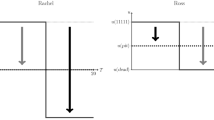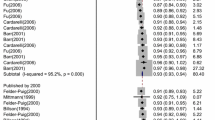Abstract
The present article provides a brief historical background on the development of utility measurement and cost-utility analysis in healthcare. It then outlines a number of research ideas in this field that the author never got to.
The first idea is extremely fundamental. Why is health economics the only application of economics that does not use the discipline of economics? And, more importantly, what discipline should it use? Research ideas are discussed to investigate precisely the underlying theory and axiom systems of both Paretian welfare economics and the decision-theoretical utility approach. Can the two approaches be integrated or modified in some appropriate way so that they better reflect the needs of the health field?
The investigation is described both for the individual and societal levels. Constructing a ‘Robinson Crusoe’ society of only a few individuals with different health needs, preferences and willingness to pay is suggested as a method for gaining insight into the problem.
The second idea concerns the interval property of utilities and, therefore, QALYs. It specifically concerns the important requirement that changes of equal magnitude anywhere on the utility scale, or alternatively on the QALY scale, should be equally desirable. Unfortunately, one of the original restrictions on utility theory states that such comparisons are not permitted by the theory. It is shown, in an important new finding, that while this restriction applies in a world of certainty, it does not in a world of uncertainty, such as healthcare. Further research is suggested to investigate this property under both certainty and uncertainty.
Other research ideas that are described include: the development of a precise axiomatic basis for the time trade-off method; the investigation of chaining as a method of preference measurement with the standard gamble or time trade-off; the development and training of a representative panel of the general public to improve the completeness, coherence and consistency of measured preferences; and the investigation, using a model of a very small society, of the conflict between the patient perspective and the societal perspective regarding preferences.
Finally, it is suggested that an important area of research, which the author never got to, would be to work closely with specific decision makers on specific decision problems, to help them formulate the problem, provide useful analyses, and to publish these as case studies to give the field a better understanding of the problems and the needs of decision makers.
Similar content being viewed by others
Notes
For ease of understanding,the axioms are expressed here in simple words,rather than the usual mathematical statements.
References
Birch S, Gafni A. Cost-effectiveness and cost-utility analyses: methods for the non-economic evaluation of health care programmes and how we can do better. In: Geisler E, Heller O, editors. Managing technology in health care. Norwell (MA): Kluwer Academic Publishers, 1996: 51–68
Gold MR, Siegel JE, Russell LB, et al. Cost-effectiveness in health and medicine. New York: Oxford University Press, 1996
Garber AM, Phelps CE. Economic foundations of cost-effectiveness analysis. Stanford (CA): National Bureau of Economic Research, 1995
Garber AM, Phelps CE. Economic foundations of cost-effectiveness analysis. J Health Econ 1997 Feb; 16 (1): 1–31
Tsuchiya A, Williams A. Welfare economics and economic evaluation. In: Drummond M, McGuire A, editors. Economic evaluation in health care: merging theory with practice. Oxford: Oxford University Press, 2001: 22–45
Dolan P, Edlin R. Is it really possible to build a bridge between cost-benefit analysis and cost-effectiveness analysis? J Health Econ 2002 Sep; 21 (5): 827–843
Raiffa H. Decision analysis: introductory lectures on choices under uncertainty. Reading (MA): Addison-Wesley, 1968
Drummond MF, Sculpher MJ, Torrance GW, et al. Methods for the economic evaluation of health care programmes. 3rd ed. Oxford: Oxford University Press, 2005
Luce R, Raiffa H. Games and decisions. New York: Wiley, 1957
Dyer JS, Sarin RK. Measurable multiattribute value functions. Oper Res 1979 Jul–Aug; 27 (4): 810–822
Dolan P, Gudex C, Kind P, et al. Valuing health states: a comparison of methods. J Health Econ 1996; 15: 209–231
Torrance G. Toward a utility theory foundation. Health Serv Res 1976; 11 (4): 349–369
Buckingham K, Devlin N. A theoretical framework for TTO valuations of health. Health Econ 2006; 15 10): 1149–1154
Keeney R. Siting energy facilities. New York: Academic Press, 1980
Keeney R, Lathrop J, Sicherman A. An analysis of Baltimore gas and electric company’s technology choice. Oper Res 1986; 34 (1): 18–39
Keeney R, Von Winterfeldt D, Eppel T. Eliciting public values for complex policy decisions. Mgmt Sci 1990; 36 (9): 1011–1030
Kassirer J, Moskowitz A, Lau J, et al. Decision analysis: a progress report. Ann Intern Med 1987; 106: 275–291
Acknowledgements
The author received no funding for the preparation of this article, and has no conflicts of interest with regard to the material herein. He would, however, like to acknowledge the subliminal help from all of his colleagues, with whom he has discussed and debated many of these issues over the decades. In addition, he is grateful for the helpful comments and suggestions from participants at the O’Brien Conference, as well as those from the referees.
Author information
Authors and Affiliations
Corresponding author
Rights and permissions
About this article
Cite this article
Torrance, G.W. Utility Measurement in Healthcare. Pharmacoeconomics 24, 1069–1078 (2006). https://doi.org/10.2165/00019053-200624110-00004
Published:
Issue Date:
DOI: https://doi.org/10.2165/00019053-200624110-00004




